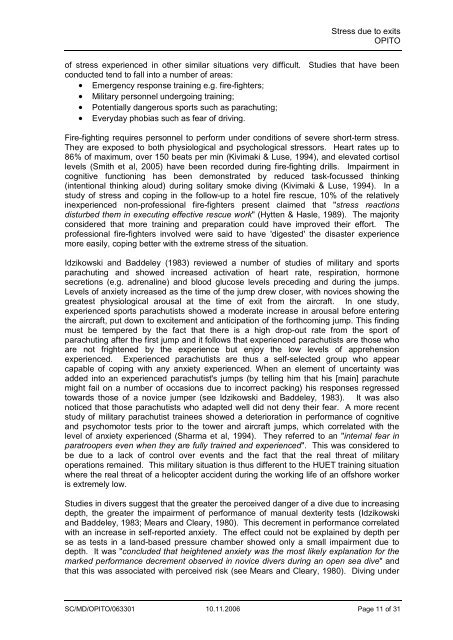Stress levels associated with huet - Opito
Stress levels associated with huet - Opito
Stress levels associated with huet - Opito
You also want an ePaper? Increase the reach of your titles
YUMPU automatically turns print PDFs into web optimized ePapers that Google loves.
<strong>Stress</strong> due to exits<br />
OPITO<br />
of stress experienced in other similar situations very difficult. Studies that have been<br />
conducted tend to fall into a number of areas:<br />
• Emergency response training e.g. fire-fighters;<br />
• Military personnel undergoing training;<br />
• Potentially dangerous sports such as parachuting;<br />
• Everyday phobias such as fear of driving.<br />
Fire-fighting requires personnel to perform under conditions of severe short-term stress.<br />
They are exposed to both physiological and psychological stressors. Heart rates up to<br />
86% of maximum, over 150 beats per min (Kivimaki & Luse, 1994), and elevated cortisol<br />
<strong>levels</strong> (Smith et al, 2005) have been recorded during fire-fighting drills. Impairment in<br />
cognitive functioning has been demonstrated by reduced task-focussed thinking<br />
(intentional thinking aloud) during solitary smoke diving (Kivimaki & Luse, 1994). In a<br />
study of stress and coping in the follow-up to a hotel fire rescue, 10% of the relatively<br />
inexperienced non-professional fire-fighters present claimed that "stress reactions<br />
disturbed them in executing effective rescue work" (Hytten & Hasle, 1989). The majority<br />
considered that more training and preparation could have improved their effort. The<br />
professional fire-fighters involved were said to have 'digested' the disaster experience<br />
more easily, coping better <strong>with</strong> the extreme stress of the situation.<br />
Idzikowski and Baddeley (1983) reviewed a number of studies of military and sports<br />
parachuting and showed increased activation of heart rate, respiration, hormone<br />
secretions (e.g. adrenaline) and blood glucose <strong>levels</strong> preceding and during the jumps.<br />
Levels of anxiety increased as the time of the jump drew closer, <strong>with</strong> novices showing the<br />
greatest physiological arousal at the time of exit from the aircraft. In one study,<br />
experienced sports parachutists showed a moderate increase in arousal before entering<br />
the aircraft, put down to excitement and anticipation of the forthcoming jump. This finding<br />
must be tempered by the fact that there is a high drop-out rate from the sport of<br />
parachuting after the first jump and it follows that experienced parachutists are those who<br />
are not frightened by the experience but enjoy the low <strong>levels</strong> of apprehension<br />
experienced. Experienced parachutists are thus a self-selected group who appear<br />
capable of coping <strong>with</strong> any anxiety experienced. When an element of uncertainty was<br />
added into an experienced parachutist's jumps (by telling him that his [main] parachute<br />
might fail on a number of occasions due to incorrect packing) his responses regressed<br />
towards those of a novice jumper (see Idzikowski and Baddeley, 1983). It was also<br />
noticed that those parachutists who adapted well did not deny their fear. A more recent<br />
study of military parachutist trainees showed a deterioration in performance of cognitive<br />
and psychomotor tests prior to the tower and aircraft jumps, which correlated <strong>with</strong> the<br />
level of anxiety experienced (Sharma et al, 1994). They referred to an "internal fear in<br />
paratroopers even when they are fully trained and experienced". This was considered to<br />
be due to a lack of control over events and the fact that the real threat of military<br />
operations remained. This military situation is thus different to the HUET training situation<br />
where the real threat of a helicopter accident during the working life of an offshore worker<br />
is extremely low.<br />
Studies in divers suggest that the greater the perceived danger of a dive due to increasing<br />
depth, the greater the impairment of performance of manual dexterity tests (Idzikowski<br />
and Baddeley, 1983; Mears and Cleary, 1980). This decrement in performance correlated<br />
<strong>with</strong> an increase in self-reported anxiety. The effect could not be explained by depth per<br />
se as tests in a land-based pressure chamber showed only a small impairment due to<br />
depth. It was "concluded that heightened anxiety was the most likely explanation for the<br />
marked performance decrement observed in novice divers during an open sea dive" and<br />
that this was <strong>associated</strong> <strong>with</strong> perceived risk (see Mears and Cleary, 1980). Diving under<br />
SC/MD/OPITO/063301 10.11.2006 Page 11 of 31




